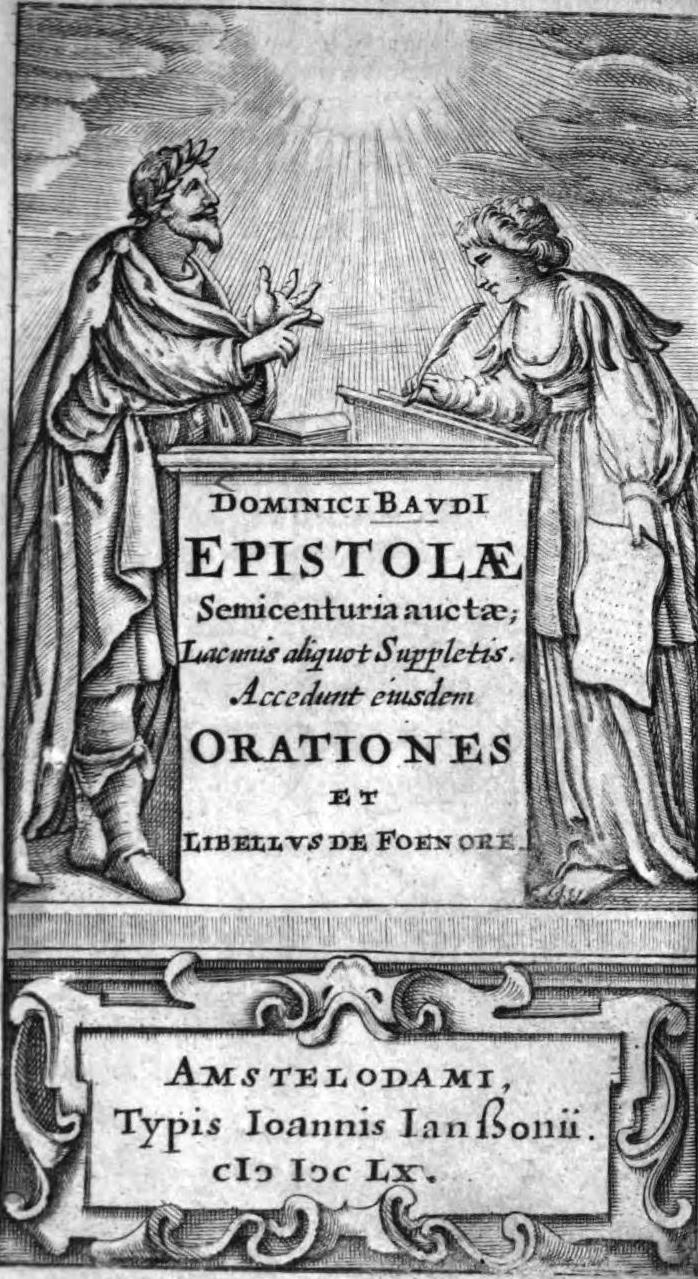Project Summary
Funded by the Leverhulme Trust, the project will produce the first critical edition of the letters of the northern European poet-historian Dominicus Baudius (1561-1613). Baudius’ habitual frankness ensured that his letters were heavily censored when published after his death, and over 150 manuscript sources will be used to repair this censorship and study its motives. The new edition, in three volumes, will contain around 450 letters, many published here for the first time. It will show how such printed letter-collections were filtered and manipulated by their earliest editors in order to project an idea of the proper business and preoccupations of the Renaissance scholar.

Background
Modern accounts of the intellectual culture of Renaissance Europe depend upon letters of scholars published in the sixteenth and seventeenth centuries. This project will use the letters of one such scholar, the poet-historian Dominicus Baudius (1561-1613), as a case study to show how these printed letter-collections were filtered and manipulated by their earliest editors. These early editors did not simply print the letters they could find: they carefully selected, excerpted and edited a subset of the available letters in accordance with principles they chose not to articulate. This project will produce a critical edition of Baudius’ correspondence which will use manuscript evidence to restore these omissions. More unusually, it will identify precisely what early editors chose not to print, and ask why they chose not to print it. The new edition will draw attention to patterns of suppression in this correspondence, a task incompletely or only accidentally achieved by other modern editions.
Readers of such letter collections printed in the sixteenth and seventeenth centuries often encounter lines of asterisks or dots which interrupt the text. At these moments, the reader is invited to notice that something is being deliberately withheld: the editor has chosen to conceal a name, to omit a phrase, or to abbreviate a longer passage. The editors who marked their omissions in such ways tended to be textual scholars, or at least people who were familiar with the techniques and expectations of textual scholarship. In the hands of such editors, these asterisks are a kind of confession, a gesture towards editorial honesty and textual integrity. Thus the early modern editor is scrupulous enough to confess that he has tampered with the text, but not scrupulous enough to explain how or why he has done so.
This variety of early modern editorial intervention has no name. It may be called ‘censorship’, or ‘expurgation’, or an application of ‘decorum’, but no term is an exact fit. The current state of our knowledge makes it difficult to draw conclusions about the motives behind these editorial decisions. Modern editors who notice such interventions have tended to see it as their job to mend the text, and enable their reader to move on through the document with as little inconvenience as possible. That is, modern editors, like their early modern counterparts, have tended to make such breaches in the text invisible, or barely visible. This project will create an edition which highlights and examines these disruptions in detail in the headnotes and the footnotes, and more broadly in the general introduction.
Baudius’ letters were valued by contemporary readers for their elegant Latin, their abundant Greek, and for their literary sophistication and allusiveness. They have been chosen for this project for several reasons.
- The correspondence was printed fourteen times between 1615 and 1662, which makes it the most widely read, and regularly re-edited, collection of the century.
- Although printed letter-collections were censored before the seventeenth century, particularly by their own authors, Baudius’ letters stand at the beginning of a distinctive phase, as editors confidently asserted control over their subjects.
- Baudius’ letters are among the most extensively censored of all collections printed in the seventeenth century.
- Baudius’ letters are the most ostentatiously censored of the period.
Baudius’ published correspondence provokes and frustrates its readers. Its pages are regularly punctuated by lines of asterisks and dots, a convention which is not explained by the anonymous first editor. Some numbers will give an idea of the pervasiveness of the issue. The first edition of 1615 prints 232 letters. Of these, 86 letters are visibly censored in some way, and censorship is marked in no fewer than 163 places. In addition, the names of the recipients of five letters are concealed, and many names which occur within the letters are omitted or obscured. Manuscripts of the letters reveal that alongside this highly visible, ‘noisy’, censorship, more passages were silently censored on publication. Many potentially controversial letters – such as Baudius’ letters on religious affairs – were excluded entirely from the printed collection.
Later editions of the correspondence expanded the corpus, but some of these new letters were also censored, this time by different editors working in accordance with different motives. Later editors attempted to mend or minimise some of the censorship of earlier editions. Although these repairs were sometimes made on the basis of new manuscript evidence, more often these corrections were merely plausible conjectures, silently implemented and subsequently adopted by later editions. Modern readers, consulting only the latest editions, have taken these editorial guesses at face value. The issues are compounded by the intervention of a succession of printers, some of whom evidently disliked the untidiness, the sense of incompleteness, which marks of censorship introduced into their products, and so they silently reduced or eliminated them so that some letters appear uncensored in later editions.
The transmission of Baudius’ letters is profoundly untidy, but in its messiness lie clues to a wide range of sensitivities, agendas and assumptions. Letter-collections are, by their nature, usually found scattered or disintegrated. Their preservation is fragmentary, and the survival of their components often seems accidental. This project will not attempt to draw a distinction between active suppression and the passive censorship which is a result of sustained neglect. It will proceed on the premise that there are no accidental omissions, that everything now lost has been lost for a reason. The project will identify as many of these reasons as possible.
Objectives and Methods
The primary objective of the present project is to publish in three volumes the first critical edition of Baudius’ correspondence. Baudius’ letters are sophisticated and their textual tradition is complex: the edition will present this material in a form that will make it accessible and useful to modern researchers. In this sense, it will do for the collection what other landmark editions have done for comparable, and comparably large, primary resources: it will locate disparate documents, order them, present them, clarify and explain them. Large collections of precisely dated and located documents like this are very valuable to historians.
The new edition will restore many censored passages in the letters. Most of these will be restored from manuscript evidence. Where manuscript evidence is unavailable, the new context provided for the letters by a systematic modern critical edition will allow some passages to be restored by conjecture with a high degree of confidence. The new edition will also enable the conjectural supplements of seventeenth-century editors to be relegated to footnotes, where they can be studied as phenomena in their own right. The restoration of the collection will transform a valuable but frustrating and sometimes misleading set of documents into a reliable and substantial new source.
The new edition will attempt the more ambitious task of reorienting the way historians approach collections such as these. Most users of such editions only consult a small number of letters, and the limitations of the collection as a whole remain invisible to such users. The new edition will be unlike others because it will take particular care to highlight omitted and censored material. It will restore material deliberately excluded from the early editions; it will outline what we do not have or cannot restore; it will discuss the nature of the absent material; and it will expand upon the reasons for its loss. The edition will be structured and presented to make it harder to ignore the missing material, and the reasons for its omission. The introduction to the edition will examine not just the letters themselves, but their fortunes at the hands of subsequent editors.


Baudius, image of 1613
(c) P. Botley 2023
